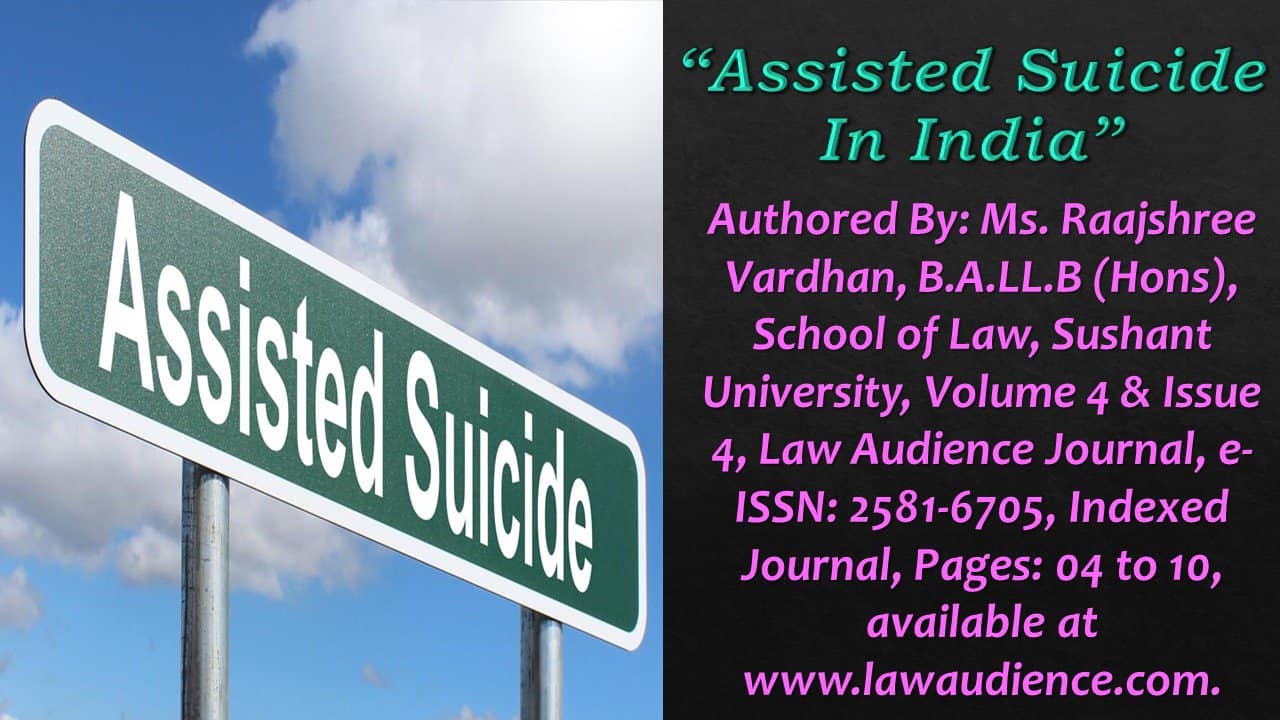Click here to download the full paper (PDF)
Authored By: Ms. Raajshree Vardhan (B.A.LL.B (Hons)), School of Law, Sushant University,
Click here for Copyright Policy.
ABSTRACT:
“This article paper gives an introduction to assisted suicide in India. The author speaks about the topic and its aspects in detail to make readers understand better. As the article unfolds, the author also lays emphasis on the challenges surrounding assisted suicide in India. The author has taken under consideration the outlook of people from various religions as to what they think about PAS. The overall purpose of this article is to give an explicit idea to readers about the need to have a clear idea about PAS. The aforementioned topic has been a subject of debate, drawing a multitude of diverse opinions from various segments of the society. This article includes introduction, right to die, religious diversities and concept of suicide, current status, medical professionals on PAS, followed by a conclusion”.
I. INTRODUCTION:
Physician-assisted suicide (PAS), is a matter of contention that has recently attracted the attention of the media, the public, politicians, and the medical community. Despite the very fact that active euthanasia and PAS are illegal in most countries, with exceptions being the Switzerland and the Netherlands, there’s pressure from some patient advocacy groups to legalise the practice in and around Europe, which could have a worldwide impact. Because we live in a multicultural and multireligious world, it is important to comprehend the role of culture and religion in decision-making, particularly within the field of PAS. The definition of euthanasia varies by country, but it’s commonly characterised as “an intentional action conducted with the express goal of ending a life in order to relieve persistent suffering[1].” PAS is that the practice of giving a patient a prescription for medication that the patient can use to end his or her life; the patient would have to self-administer the medication, either directly or by a machine. The cultural, religious, and economical roots behind the various opinions on assisted suicide held by various sections of society have received insufficient attention. Cultural differences may explain for a few inequalities in assisted suicide, consistent with recent research. Despite the very fact that there is little research on PAS in India, a survey claims that 60 out of 100 Indian doctors (28 men and 32 women) answered a questionnaire. there have been 26 Hindus, 23 Christians, and 10 Muslims among the doctors, who had a mean age of 35.4 years and 10.2 years of experience. Overall, 26.6 percent agreed that euthanasia could be an option for people with motor neuron disease, while 25% agreed that euthanasia might be used for cancer patients. Four Christian doctors and 16 Hindu doctors (8 male and 8 female) backed euthanasia[2]. To our knowledge, no study has been conducted to analyse the attitudes of the overall public and professionals in particular who may be involved in caring for some members of society who may contemplate discussing PAS or euthanasia. Fasts are protected under the constitution, consistent with Jain leaders, who claim that people have the right to die with dignity. This discussion has sparked a debate in India about the proper way to die, where euthanasia is against the law and suicide is a crime punishable by imprisonment for those who attempt suicide. Some people are concerned that if PAS is authorised, it might be abused. However, when such legislation is enacted, “systems” must be in place to ensure that the law is not being exploited. this is often where expert judgement will play a part, and psychiatrists could also be called in to assess mental competence, psychological state, and determine whether an individual is eligible for PAS if the courts decide to legalise it in India in the future. When making such decisions, other professional groups like social services, palliative care professionals, and psychologists could also be involved.[3]
II. RIGHT TO DIE:
Every person has the right to die with dignity, which incorporates the ability to choose the timing of one’s death and the ability to accept medical and pharmaceutical aid in order to die without pain. For supporting an individual in the free exercise of this right, no physician, nurse, or pharmacist shall be considered criminally or civilly accountable. Because many patients on respirators are unconscious, they’re unable to express whether they wish to live or die. Montana is on the verge of becoming the third state to authorise assisted suicide. If the Supreme Court upholds an inferior court verdict from last year, Montana will become the state to include the right in its constitution. The Constitution may be a social document. In its political aspect, it’s the society. we will not comprehend its nature until we first comprehend the society’s primary traits. as long as the constitution considers the social structure will it be able to withstand the test of time. Together, the constitution and society develop, expand, and become entwined.
Changes and developments in society are included into the constitution, they’re as follows:
a) Right to education
b) Right to wash environment
c) Right to life
d) Right to travel abroad
e) Right to privacy
f) Right against solitary confinement.
Ours may be a democratic government, which suggests it is run by, of, and for the people. The people’s power is enshrined within the Constitution. it’s the power of the people for the benefit of the people. The Constitution establishes rights and duties. All of our requests are translated into rights, including our feelings and emotions, which are guided by our rights and duties. As we’ve the right to live a dignified life, we should always also have the right to die when it is required by law under certain circumstances. The sanctity of life has been elevated to the very best level in India.[4]
III. RELIGIOUS DIVERSITIES AND CONCEPT OF SUICIDE:
III.I HINDUISM:
According to Hinduism, a person the one who commits suicide does not go to hell or heaven, but rather remains on Earth as an evil spirit who wanders aimlessly till the end of his or her life. After that, the person travels to hell, only to return to earth to finish his or her “karma”. Suicide is regarded a violation of the Ahimsa (non-violence) precept, and is thus as immoral as murder. If a person commits suicide and becomes Abhisasta (a person accused of committing a grievous sin), his blood relatives (sapinda) are not permitted to execute the funerary rites.
III.II SHISKHAPATRI:
Swaminarayan’s teachings consist of 212 Sanskrit verses that discuss dos and don’ts, as well as the prohibition of suicide even in holy places.
III.III ISLAM:
Euthanasia or mercy killing is forbidden in Islam because it encompasses a positive role on the part of the physician to end the life of the patient and quicken his death via fatal injection, electric shock, a sharp instrument, or any other means, says Prof Yusuf Al-Qardhawi (Islamic scholar)[5]. This is a murderous deed, and murder is a significant sin in Islam, hence it is prohibited. “Do not harm yourselves, because Allah has been compassionate to you and (Allah) is the one who gave your life, and he will ordain your death, and then he will give you life again, indeed mankind is ungrateful.” Most Muslims believe that suicide, attempted suicide, assisted suicide, and euthanasia are all forbidden in Islam, based on these Quranic texts.
III.IV CHRISTIANITY:
Suicide is regarded a major sin by Catholic theology, and this idea is based on another notion that life is God’s property and a gift to this world, and no one else has the authority to take it away. “We should not despair of the eternal salvation of those who have taken their own lives,” the Catholic Church’s Catechism teaches. God can provide the opportunity for beneficial repentance in ways that only he knows about. “The Church prays for those who have committed suicide.” According to scripture, if a person comes to trust in Jesus Christ, all sin they will ever commit is paid for, and “there is now no condemnation for those who are in Christ Jesus,” as well. Suicide is considered a sin by Christians, although they do not feel it is impossible to find forgiveness.
III.V SIKHISM:
The Gurus, according to the Sikhs, rejected suicide since no one has the authority to grant or take life. Birth and death are at the mercy of the creator, leading to the view that mercy killing or PAS has no place in Sikhism. By giving medical assistance and pain relief, the Gurus addressed the problem of sickness and suffering.
III.VI BUDDHISM:
Suicide is undoubtedly considered as a negative sort of conduct by Buddhists, as the first precept is to refrain from the destruction of life, even one’s own. While suicide as self-sacrifice may be permissible for an Arhat (a spiritual practitioner who has accomplished certain high degrees of attainment), one who has attained enlightenment, Buddhism in its various forms affirms that it is still the exception to the norm.
III.VII JAINISM:
One religion that allows for restricted suicide is Jainism. Due to a strong emphasis on nonviolence, Jain Munis and other old people have been known to starve themselves to death. There is no record of any other violent tactics being used. “When a knowledgeable man, in whatever way, comes to know that the allocated space of his existence draws nearer its end, he should in the interim promptly study the art of dying a pious death,” says Sutra krtraanga in the Jain scriptures.
III.VIII JUDAISM:
In all aspects, a person who is dying is recognised as a live person. It is forbidden to close a dying person’s eyes. “It is like a sputtering light that is extinguished as soon as a person touches it so too, whomever closes the eyes of a dying person is like having removed the soul,” Rabbi Meir would say. Jews are prohibited from assisting or asking suicide help. “Do not put a stumbling stone ahead of the blind,” states Leviticus 19:14, and therefore the Rabbis interpreted that verse to ban any form of physical, theological, economic, or moral obstacle , even supporting suicide.[6]
IV. CURRENT STATUS IN INDIA:
The heart-breaking story of Aruna Shanbaug, a nurse who has been in a vegetative condition for the past 37 years after being severely assaulted by a medical staff, has recently made headlines at Mumbai’s King Edward Memorial (KEM) Hospital. When the news broke that Aruna’s euthanasia plea had been denied by the Indian Supreme Court, the nurses caring for her at the KEM were overjoyed, hugging one other and spending out sweets to other staff members[7]. The Indian legal code (IPC) governs the legal position of PAS and euthanasia in India. The IPC addresses both active and passive euthanasia, also as PAS. Active euthanasia may be a crime under Section 302 (murder punishment) or at the very least Section 304 of the Penal Code 1860 (punishment for culpable homicide not amounting to murder).
The excellence between euthanasia and physician-assisted death is who administers the lethal dose: in euthanasia, a doctor or a 3rd party does so, but in physician-assisted death, the patient does it himself. In India, PAS’ legal standing would be abetment to suicide under IPC Section 306 (abetment to suicide). So, theoretically, anyone considering euthanasia or PAS must undergo Indian courts, and therefore the courts have never granted a clear verdict permitting a PAS to proceed. India isn’t alone in this regard; most countries have been attempting to obtain rulings on the subject.
In India, the matter of attempted suicide has received more attention, and therefore the IPC Section 309 acknowledges it as a criminal offence. “Whoever attempts to kill and does any act towards the commission of such offence shall be punished with simple imprisonment for a term not exceeding one year or with fine, or with both”. Section 309 of the IPC has been challenged in Indian courts on several occasions, including within the case of P. Rathinam vs. Union of India[8], during which the Supreme Court held that the right to life referred to in Article 21 includes the right not to live a forced life, and thus section 309 violates Article 21. However, in the case of Gian Kaur vs. State of Punjab[9], a Constitution Bench of the Supreme Court overruled this decision, holding that Article 21 couldn’t be construed to include the “right to die” as a part of the fundamental right guaranteed therein; thus, it couldn’t be validly stated that section 309 violates Article 21.[10]
V. MEDICAL PROFESSIONALS ON PAS:
India may be a healthy example of a diverse range of cultures, customs, and faiths that have all maintained their identities while blending with traditional Indian ideologies and rituals. within the Indian context, untangling religion and culture, customs and rituals, and beliefs and attitudes are a Herculean effort. knowledgeable and public discussion of PAS will encounter a variety of issues, like people’s moral standards, how religion and culture will interact in people’s minds, whether intensity of religiosity will trump quite religion, and so on. More religious doctors, whether Christians or Muslims, believed that PAS shouldn’t be considered since it would be against their faith[11]. Only a small amount of information about Indian doctors’ attitudes toward euthanasia and PAS have been published. Although the study cited earlier provides some insight, generalization is impossible thanks to the small sample size. The attitude of Indian doctors, particularly psychiatrists, oncologists, palliative care physicians, and geriatricians, toward the notions of euthanasia and PAS, have to be studied further.
VI. CONCLUSION:
In conclusion, there have always been and will continue to be debates between those who support and oppose euthanasia and PAS. People claim that hospitals do not listen to patients’ requests, especially when they are terminally sick, crippled, or unable to respond to medical treatment. This medical culture will undoubtedly change as a result of the new legislation that may be enacted if the PAS is allowed. Psychiatrists must deal with mental capacity difficulties on a regular basis; therefore, this topic is becoming increasingly significant to them. In order to draw meaningful conclusions on the necessity for euthanasia and PAS in India, empirical study on the issues of views and attitudes about euthanasia and PAS among large numbers of professionals and the general population is required.
Cite this article as:
Ms. Raajshree Vardhan, “Assisted Suicide In India”, Vol.4 & Issue 4, Law Audience Journal (e-ISSN: 2581-6705), Pages 04 to 10 (12th October 2022), available at https://www.lawaudience.com/assisted-suicide-in-india/.
Footnotes & References:
[1] Harris NM, The euthanasia debate, J R Army Med Corps. 2001;147:367–70.
[2] Abbas SQ, Abbas Z, Macaden S., Attitudes towards euthanasia and physician-assisted suicide among Pakistani and Indian doctors: A survey, Indian J Palliat Care. 2008;14:71–4.
[3] Farooq Khan & George Tadros, Physician-assisted Suicide and Euthanasia in Indian Context: Sooner or Later the Need to Ponder!, available at https://www.ncbi.nlm.nih.gov/pmc/articles/PMC3701348/.
[4] Shah Ishfaq, Right To Die, available at legalserviceindia.com.
[5] Al-Qardhawi Y., Should euthanasia and physician assisted suicide be legal? Living Shariah: Fatwa Bank. 2005, available at http://www.IslamOnline.net.
[6] supra note 3.
[7] Avantika Kukreti, KEM nurses hail SC order on Aruna Shanbaug, available at https://www.indiatoday.in/india/west/story/kem-nurses-hail-sc-order-on-aruna-shanbaug-129891-2011-03-07.
[8] 1994 AIR 1844, 1994 SCC (3) 394.
[9] 1996 AIR 946, 1996 SCC (2) 648.
[10] supra note 3.
[11] Tadros G, Rakhawy MY, Khoweiled A, El-Houssini AM, Khan F., Perception of physician-assisted suicide among Egyptian psychiatrists: Cultural perspective. The Psychiatrist. 2011; 35:15–8.




